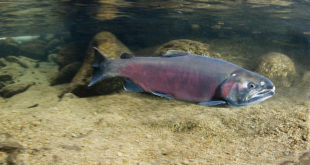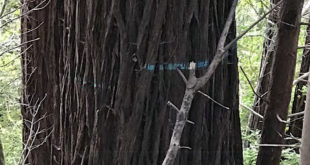November 26, 2017
SUBJECT: THP 1-15-042 SON (Gualala Redwoods Timber LLC “Dogwood” THP, reopened public comment) CAL FIRE Forest Practice Program:
Attached are my comment letters on the original and recirculated THP versions for the “Dogwood” Timber Harvest Plan 1-15-042, from 2015-2016. I am resubmitting these comments for the resubmitted THP of the same file number, which is substantially the same. All my previous comments are incorporated by reference here and attached. Please include them in the administrative record for the resubmitted Dogwood THP.
Environmental conditions relevant to cumulative impacts on listed threatened or endangered fish and wildlife species (steelhead, coho salmon, California red-legged frogs), special-status plant species populations, and floodplain wetlands have changed since the previous versions of the THP. High winter flows in late 2015-2016 activated floodplain submergence, flooding, and sediment transport affecting wetlands, special-status plants, ephemeral submerged floodplain fish and velocity refuge habitat, and sediment deposition between the active river channel and floodplain. In addition, portions of the Dogwood THP were harvested along the Buckeye Creek floodplain, where intensive ground disturbance (exposed and mechanically loosened surface soils and sediments) and floodplain road use (skid roads) occurred in floodplain wetlands with obvious wetland indicators (slough sedge marsh). CAL FIRE has approved or considered additional timber harvest plans with direct, indirect, and cumulative impacts in Gualala River floodplains/flood-prone areas (including but not limited to Plum and German South THPs). Merely enumerating or identifying these as cumulative projects, without substantive analysis of specific cumulative impacts to wetlands, rare plants, floodplain ecology, endangered/threatened wildlife habitat and populations, does not provide an actual analysis of cumulative impacts to these floodplain-related resources. These significant impacts and changed environmental context for the timing of proposed, resubmitted Dogwood timber harvest activities have not been analyzed or mitigated in the resubmitted Dogwood THP.
The failure to provide an evidence-based, documented account of existing floodplain wetlands, and significant impacts to wetlands, remains outstanding in the current THP. The THP disregards the obvious evidence for floodplain wetland habitats (as habitat classification in CEQA context, and also the narrower Clean Water Act Section 404 fill discharge context) in the form of National Wetland Inventory maps that identify seasonal wetlands beyond “wet areas” as defined in Forest Practice Rules, and the extensive occurrence of slough sedge seasonal marsh (Carex obnupta) patches in broad depressional areas of the floodplain, in entisols (young floodplain sediments, geomorphically immature soils that do not develop the same hydromorphic indicators as soil profiles). Without actual seasonally timed protocol plant surveys, there remains no meaningful evidence to support impact analysis or mitigation for rare plants. It is not possible to avoid or minimize impacts to rare plants if they have not been detected by properly timed surveys (compliant with CDFW protocols) conducted by qualified botanists. The resubmitted Dogwood THP also continues to wholly disregard, without justification, CAL FIRE’s own primary scientific guidance for methods of analysis of flood-prone area impacts: the 2005 white paper by CAL FIRE’s riparian protection committee (Cafferata et al. 2005) on floodprone considerations in the redwood forest zone. CAL FIRE has also continued to disregard floodplain impacts to listed salmonids (steelhead) and its designated critical habitat in floodplains of the Gualala River. These omissions continue to result in significant unanalyzed and unmitigated impacts, as explained in my attached letters. Most of these impacts directly result from noncompliance with flood-prone and Anadromous Salmonid Protect rules that prohibit disturbances, including skid roads, in flood-prone areas. In granting an exception to these rules, significant impacts will result from extensive ground disturbance in floodplains, including ephemeral intermittent salmonid foraging habitat, rare plant habitat, and permanent wetlands, and will occur without mitigation. I urge CAL FIRE to rigorously re-analyze, in consultation with qualified experts, potentially significant impacts of the Dogwood THP. This THP should not be approved as proposed. Disturbances to flood-prone areas should be disapproved without exceptions to Forest Practice Rules.
Respectfully submitted,
Peter R. Baye, Ph.D.

 Friends of Gualala River Protecting the Gualala River watershed and the species living within it
Friends of Gualala River Protecting the Gualala River watershed and the species living within it


